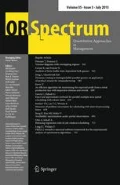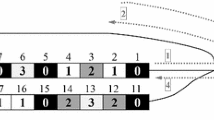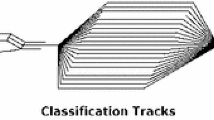Abstract
This paper considers a decision problem as it arises in a rail–road transshipment yard when unloading a bundle of trains. The loading units, e.g. containers, arriving on trains and occasionally arriving on trucks have to be placed on storage lanes of limited capacity. Loading units are placed and removed keeping stacking and crane rail moves small. We present two NP-hard models and some heuristics for solving the problem. One of these heuristics is currently applied at the yard. The algorithms are then tested using real-life data.
Similar content being viewed by others
References
Alicke K, Arnold D (1998) Modellierung und Optimierung von mehrstufigen Umschlagsystemen. Fördern und Heben 8:769–772
Borgman B, van Asperen E, Dekker R (2010) Online rules for container stacking. OR Spectr 32: 687–716
Bostel N, Dejax P (1998) Models and algorithms for container allocation problems on trains in a rapid transshipment shunting yard. Transp Sci 32: 370–379
Boysen N, Fliedner M (2010) Determining crane areas in intermodal transshipment yards: the yard partition problem. Eur J Oper Res 204: 336–342
Boysen N, Jaehn F, Pesch E (2010) New bounds and algorithms for the transshipment yard scheduling problem. J Scheduling. doi:10.1007/s10951-010-0200-2
Boysen N, Jaehn F, Pesch E (2011) Scheduling freight trains in rail–rail transshipment yards. Transp Sci 45: 199–211
Bruns F, Knust S (2010) Optimized load planning of trains in intermodal transportation. OR Spectr. doi:10.1007/s00291-010-0232-1
Caserta M., Voß S, Sniedovich M (2009) Applying the corridor method to a blocks relocation problem. OR Spectr 31: 1–15
Corry P, Kozan E (2006) An assignment model for dynamic load planning of intermodal trains. Comput Oper Res 33: 1–17
Corry P, Kozan E (2008) Optimised loading patterns for intermodal trains. OR Spectr 30: 721–750
Dekker R, Voogd P, van Asperen E (2006) Advanced methods for container stacking. OR Spectr 28: 563–586
Garey M, Johnson D (1979) Computers and intractability: a guide to the theory of NP-completeness. W.H. Freeman and Company, New York
Józefowska J (2012) Just-in-time scheduling in modern mass production environment. In: Ríos-Mercado RZ, Ríos-Solís YA (eds) Just-in-time systems. Springer optimization and its applications, vol 60. Springer, Berlin, pp 171–190
Karp RM (1972) Reducibility among combinatorial problems. In: Miller RE, Thatcher JW (eds) Complexity of computer computations. Plenum Press, New York, pp 85–103
Kim KH, Hong G-P (2006) A heuristic rule for relocating blocks. Comput Oper Res 33: 940–954
Kim KH, Park YM, Ryu K-R (2000) Deriving decision rules to locate export containers in container yards. Eur J Oper Res 124: 89–101
Kombiverkehr (2008) Frachtbehälter Einteilung nach Längenklassen, UIC
Kozan E (1997) Increasing the operational efficiency of container terminals in Australia. J Oper Res Soc 48: 151–161
Montemanni R, Smith D, Rizzoli A, Gambardella L (2009) Sequential ordering problems for crane scheduling in port terminals. Int J Simul Process Model 5: 348–361
Souffriau W, Vansteenwegen P, Berghe GV, Oudheusden DV (2009) Variable neighbourhood descent for planning crane operations in a train terminal. In: Sörensen K, Sevaux M, Habenicht W, Geiger MJ (eds) Metaheuristics in the service industry. Lecture notes in economics and mathematical systems, vol 624. Springer, Berlin, pp 83–98
Stahlbock R, Voß S (2008) Operations research at container terminals: a literature update. OR Spectr 30: 1–52
Steenken D, Voß S, Stahlbock R (2004) Container terminal operation and operations research: a classification and literature review. OR Spectr 26: 3–49
Author information
Authors and Affiliations
Corresponding author
Additional information
This work has been supported by the German Science Foundation (DFG) through the Grant “Optimierung der Containerabfertigung in Umschlagbahnhöfen” (BO 3148/1-1 and PE 514/16-1).
Rights and permissions
About this article
Cite this article
Jaehn, F. Positioning of loading units in a transshipment yard storage area. OR Spectrum 35, 399–416 (2013). https://doi.org/10.1007/s00291-012-0281-8
Published:
Issue Date:
DOI: https://doi.org/10.1007/s00291-012-0281-8




